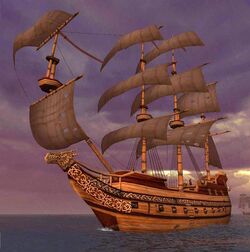 |

Heavy men-of-war are known as ships of the line, a type of heavy warship consisting of 50-100 cannons.
A man-of-war (plural men-of-war; also man of war, man-o'-war or simply man) is a term referring to an armed naval vessel in the British Royal Navy. The term was first used in the mid 17th century. Later, it not only refered to the ship of the line, but also other large warships such as Frigates, Corvettes, and Brigs.
Men-of-war carry anywhere from twenty to one-hundred cannons (depending on the variation of size and design) and are propelled primarily by sails, unlike a galley, which uses oars. The first men-of-war were generally military galleons, naus and brigs, considering those were the most common seventeenth century naval vessels.
The Man-of-War was used at the Battle of Khael Roa. Arming about 100 cannons and having over 1,000 crewmen, the Manowar is the largest ship owned capturing the HMS Belette (HMS Manowar), which fought Nathaniel Hawk and his ship off of Khael Roa. It is the second strongest ship, second only to the Black Pearl.
The legitimate Man-of-War was invented by Sir John Hawkins around the mid-1500's. It was over two hundred feet long, had up to one hundred and twenty cannon, and had three masts. A smaller version was later called the frigate.
Running a Man-of-War
Men-of-War in the British navy during the 1750's were run very strictly. No seaman was allowed alchohol or spirits apart from the usual daily ration of grog. Any disrespect given verbally or physically was generally punished by flogging on the back with a whip of cat o' nine tails. The captain and his officers were to dine in the cabin or the gunroom, while the midshipmen and seamen dined on the gundecks. During longer voyages, a biscut called hardtack was eaten.
Many of the seamen serving on men-of-war were generally pressed into the service, so mutiny was a very apparent threat.
Pirates will usually avoid engagement against a man-of war, since the well trained crews and marines aboard can blow down any pirate ship. In battle gun crews on a man-of-war consist of five to eight men, in comparison with the piratical two.
Private Men-of-War
A private man-of-war, or privateer, was a ship who's captain was given letters of marque, licensing them to attack merchant ships of nations at war with their employer's nation. Most private men-of-war were commissioned by the king himself, but there were many companies, guilds, and colony governors that hire privateers to clear the seas of pirates, and bring to them treasure stolen from hostile merchants. Rules on these ships were generally more slacked than legitimate men-of-war, and ill-use of victims, plundering, mindless drinking, and mindless killing were generally present.
One of the ways to tell between private and national men-of-war, is the flag. King's Ships display one of the three Royal Navy ensigns, while privateers are only allowed to show the national flag. Privateers are also not issued any royal marines aboard.
Notable men-of-war
Behind the scenes
- In the Pirates of the Caribbean game, the Man-of-War (actually noted as Man O' War in the game), is never encountered in the storyline, except at the Battle of Khael Roa. Arming about 100 cannons and having over 1,000 crewmen, the Manowar is the largest ship the player can own capturing the HMS Belette (HMS Manowar) which fought Nathaniel Hawk and his ship off of Khael Roa. It is the second strongest ship in the game, second only to the Black Pearl.
Appearances
- Pirates of the Caribbean (video game) (First appearance)
- Jack Sparrow: The Age of Bronze
- Pirates of the Caribbean: Isles of War
- Pirates of the Caribbean: Tides of War
